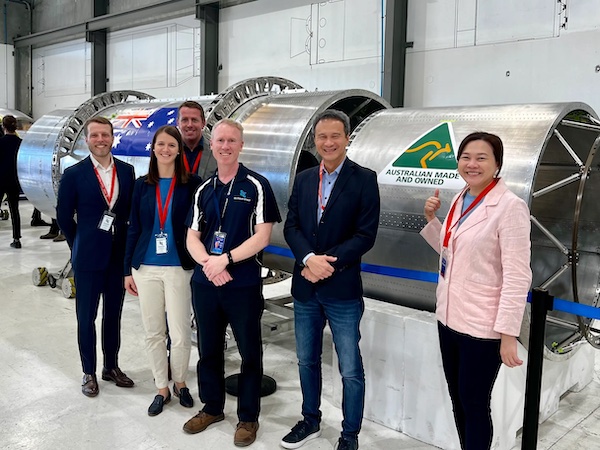Gilmour Space Rockets Ahead with AM
Australian launch services company selects EOS as its additive manufacturing partner.

Gilmour Space, EOS Asia Pacific, and Additive Australia are partnering to move from prototyping to manufacturing with AM. Image Courtesy of EOS
December 4, 2023
As Australian company Gilmour Space Technologies launches from prototyping to production, it has selected EOS, a provider of metal and plastics AM solutions, as its primary 3D printing partner.
The Queensland-based Gilmour is months away from attempting Australia’s first sovereign orbital launch from the Bowen Orbital Spaceport. Founded by two brothers in 2015, Gilmour Space is a venture-capital-backed firm developing new capabilities to launch satellites into space.
This latest project is part of the Australian Space Manufacturing Network, which is supported by funding from the Australian Government under the Modern Manufacturing Strategy. In June, Gilmour Space executed a $52 million grant agreement with the Australian federal government to advance the development and commercialization of new space technologies in the country. The $156 million Australian Space Manufacturing Network (ASMN) project establishes three new space facilities in Queensland, including a common test and manufacturing facility for members to advance their R&D at lower cost; an advanced manufacturing facility for building commercial rockets and satellites, anchored by Gilmour Space; and an orbital spaceport used to launch many of these new rockets into space.
The EOS partnership will help the Gilmour Space team establish a metal AM facility and aid in the transition from prototyping to manufacturing, according to Kevin Hazlehurst, director of Additive Australia. Metal AM will allow for generative design and fast production, turbocharging the design and manufacture of Gilmour Space’s rockets and satellites.
“We are now seeing the rules for developing space launch vehicles rewritten,” said Terrance Oh, senior vice president at EOS Asia Pacific. “We are thrilled to play a part of Gilmour Space’s ride to deliver satellites to low Earth Orbit.”
EOS sees a sizeable role for metal 3D printing in commercial space applications. The ability to manufacture prototypes and small series production with AM can accommodate extreme customer-specific requirements. Functionality of parts can also be reimagined—for example, integrating cooling channels into a combustion chamber or consolidating multiple parts into a single, all-in-one design. From a materials standpoint, AM enables use of custom materials such as copper alloys that would be difficult and expensive to produce with conventional manufacturing methods.
EOS is working with other companies aiming to conquer the space frontier. U.S. startup Launcher acquired the M 4K AM system from AMCM, an EOS Group company, to advance its orbital launch vehicle strategy. The AMCM M4K 3D printing system is being used to produce the world’s largest single-part 3D printed copper alloy combustor, and Launcher plans to additively manufacture the entire 10-ton-force E-2 rocket engine that is tasked with delivering small satellites to low Earth orbit.
This video offers a glimpse into Launcher’s strategy, including how EOS is helping companies use AM technologies to transform rocket design and manufacturing.
Subscribe to our FREE magazine, FREE email newsletters or both!
About the Author
Beth Stackpole is a contributing editor to Digital Engineering. Send e-mail about this article to [email protected].
Follow DE





